Positive Health Online
Your Country

Treating Trigger Points Reduces Pain from Knee Osteoarthritis
listed in bodywork, originally published in issue 189 - December 2011
Trigger points are hyperirritable spots in skeletal muscles, and when pressed, feel like tender 'knots' or tight bands in the muscles. Around 75% of pain is caused by trigger points; yet in spite of decades of research, it is one of the most under-diagnosed conditions in allopathic medicine.
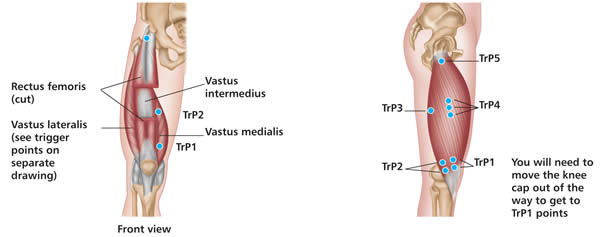
Trigger points have been researched and documented since the 1930s, initially by Dr Janet Travell of the United States; however many studies have been conducted in numerous countries since then. Initially, research consisted of diagramming referral patterns and identifying initiators/perpetuators of trigger points. More recent studies have found changes in chemical composition of the tissues surrounding trigger points, and fMRIs (functional magnetic resonance imaging) have been able to identify trigger points in muscle tissue.
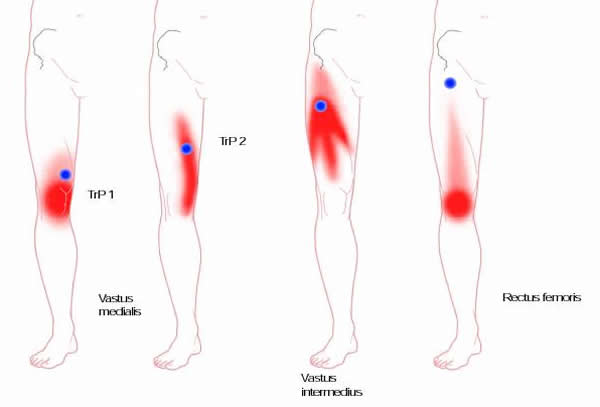
Examples of Pain Referral Patterns
Referred Pain
The most important thing to know about locating and treating trigger points is that they refer pain to a different area. You can learn where to search for trigger points in areas remote to the area you feel pain by looking at charts and books that contain 'pain guides'. For example, trigger points in the vastus medialis muscle can refer pain to the kneecap and the medial knee area, and trigger points in the vastus lateralis muscle may refer pain that feels like is it on the outside of the kneecap. Pain can feel deep, like it is in the joint, and may be mistaken for inflammation. By locating and pressing on the trigger point, you can likely reduce or eliminate pain in the area of referral.
Other Symptoms
Trigger points can cause symptoms other than pain. Trigger points in the vastus medialis muscle can cause the knee or hip to buckle unexpectedly, while those in the vastus lateralis may cause the knee to lock. Going up and down stairs may be a problem due to weakness. Range-of-motion may be restricted.
Perpetuating Factors - what causes Trigger Points and Keeps them Activated
Trigger points may form after a sudden trauma or injury, or they may develop gradually. Common initiating and perpetuating factors are mechanical stresses, injuries, nutritional problems, emotional factors, sleep problems, acute or chronic infections, and organ dysfunction and disease. Resolving these factors are crucial to getting long-term relief.
With any pain-generating condition, such as osteoarthritis, trigger points will form if pain has lasted long enough. Because inflammatory and autoimmune disorders are chronic, trigger points will be reactivated and need to be treated periodically. The more you can learn about self-help techniques and treatment, the more you can minimize your pain, and will know what to do when trigger points get reactivated.
Central Sensitization
When pain is prolonged, even just for days, there is a maladaptive response: damage to the central nervous system, particularly to the sympathetic nervous system and the hypothalamus-pituitary-adrenal (HPA) systems, called central sensitization. Certain types of nerve receptors in muscles relay information to neurons located within part of the grey matter of the spinal cord and the brain stem. The pain is amplified there and then is relayed to areas of other muscles, thereby expanding the region of pain beyond the initially affected area. Once the central nervous system is involved, persistent pain leads to long-term or permanent changes in these neurons, which affect adjacent neurons through neurotransmitters. This may also cause the part of the nervous system that would normally counteract pain to malfunction and fail to do its job. Conditions associated with chronic inflammation cause central nervous system sensitization, leading to a vicious cycle of pain.
Trigger Points, OA, and Inflammatory Joint Disease
Central sensitization from both OA and inflammatory joint disease, can induce pain beyond the region of the joint, and eventually form trigger points in the surrounding muscles. The trigger points then cause referred pain on their own. This may be why people with joint replacements still experience pain - it could be a result of trigger point pain referral, even though trigger points were not originally part of the underlying disease.
What You can Do
- Locate your trigger Points. Let's assume at least some of your trigger points causing knee pain are located in the quadriceps muscles in the front and sides of your thigh. Look at trigger point diagrams such as that at the top of this article to see where the most common trigger points are likely to be located, but search the entire muscles to make sure you are finding all the trigger points.
- Search for tender points, knots, and tight bands. Use your thumb, fingers, or some kind of hand-help pressure tool (like a golf ball or other gadget made for this purpose) to press on the tender spot for eight seconds to one minute. You can also stroke across the area. (Note: don't apply pressure over varicose veins, open wounds, phlebitis, thrombophlebitis, or where clots are or might be present.) It should 'hurt good' to press, but not hurt too much. More is not better in this case.
- Repeat treatments. Start with one treatment per day, and don't overdo it with too much pressure, or you can make your pain worse. As tenderness decreases, you can increase treatment to two to three times per day. If you start to get sore, back off on frequency and/or amount of pressure.
- See a practitioner trained in locating and treating trigger points. This is most likely a physiotherapist, physical therapist, or massage therapist, although other types of practitioners may also know about trigger points. It is helpful to have a professional guide you with your self-help treatments, and aid you in figuring out all the perpetuating factors that may be causing and keeping your trigger points activated.
- Avoid conditioning exercises initially. Activities such as weight-lifting and other conditioning exercises may aggravate your trigger points at first. Focus on stretching and breathing. With any exercise program, underestimate what you can do. Gradually add increments in duration, rate, and effort that will not cause you to be sore or reactive trigger points. If you are not sure whether your exercise is conditioning or stretching, consult with a professional. Stop doing anything that is making you feel worse. Do not do deep knee bends or squats. See a physical therapist or physiotherapist for a proper way to do knee extensions.
- Take care of your muscles. Vary your activities so you are not doing any one thing for too long. Notice where you hold tension and practice relaxing those areas. Warm up and stretch before exercising, keep your muscles warm, and lift properly.
- Bedtime laying position. If you have trigger points in the vastus medialis or vastus lateralis, sleep on the unaffected side with a pillow between your legs. Don't bring your thighs up toward your chest, and don't straighten the legs out all the way either.
- See an osteopathic physician or chiropractor for evaluation and treatment. It is important to identify and treat any lumbar vertebrae out-of-alignment or hip alignment problems. The bones in the lower leg may also be out-of-alignment, including the tibia and fibula where they attach to the femur at the knee.
- See a podiatrist or other practitioner for orthotics. Get corrective orthotics to solve foot pronation problems, and don't wear high heels. If one leg is anatomically shorter than the other, see a specialist to get a compensating lift.
When to see a Doctor
Remember that only 75% of pain is caused by trigger points. There are many causes of knee pain, including ligament strains and tears, torn meniscuses, tendonitis, bursitis, kneecap fractures, nerve entrapments, and osteoarthritis. If you still have pain after inactivating trigger points, you will need to see an orthopaedic doctor for evaluation. Even if other causes are found, there are also likely trigger points involved, and treatment can help prepare you for surgery and with recovery afterward.
Self-Treatment
Trigger points in the rectus femoris, vastus lateralis, vastus intermedius, adductors longus and brevis, vastus lateralis, vastus intermedius, gastrocnemius, hamstrings, popliteus, soleus, and sartorius muscles can all refer pain to the knee area. For example, if you feel pain around or under the kneecap, it could be from trigger points in one of the Quadriceps muscle group.
Vastus Medialis Pressure
To treat your vastus medialis, use your thumb, or a golf ball or other pressure device held in the center of the palm of your opposite hand to press into tender points. It does not take a lot of pressure to treat these trigger points.
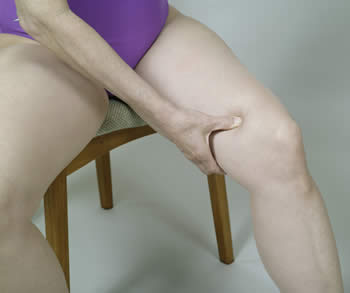
Vastus medialis pressure
Vastus Lateralis Pressure
The most common trigger points in the vastus lateralis that may cause pain around the knee area are found under the edge of the kneecap. Straighten out your leg, wrap your hands around your knee, and put both thumbs on the edge of the kneecap. Press your kneecap away from you while simultaneously pressing into trigger points in that area.
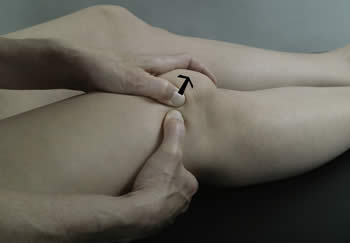
Vastus lateralis pressure
Rectus Femoris Pressure
To work on the rectus femoris and the underlying vastus intermedius, roll onto your stomach and with your leg bent, move the tennis ball around, checking for tender points. Be sure and work the entire length of the muscles.
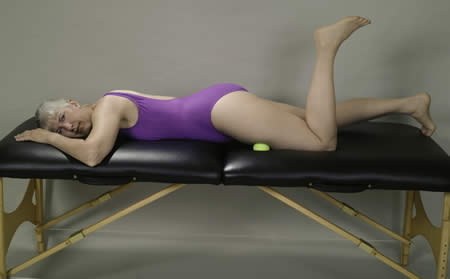
Rectus Femoris pressure
Or use a golf ball or other pressure device in the center of your palm, and press into tender points. This is less effective than lying on the ball due to the thickness of the rectus femoris muscle.
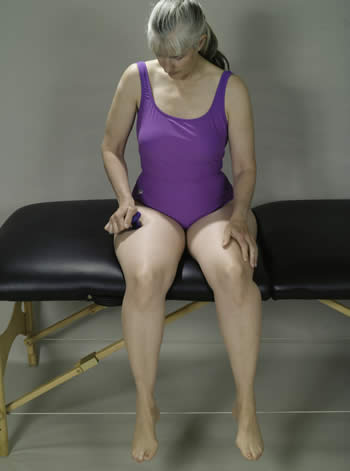
Rectus Femoris pressure
Quadriceps Side-lying Stretch
Lying in bed on your side, bend your bottom leg to almost a 90° angle to the trunk, so that you can rest your top knee on the bottom foot. Grab the ankle of your upper leg and pull it up behind you, so you are getting a stretch on the front of the thigh. Do not do this stretch if you have a lot of damage in the knee joint and ligaments.
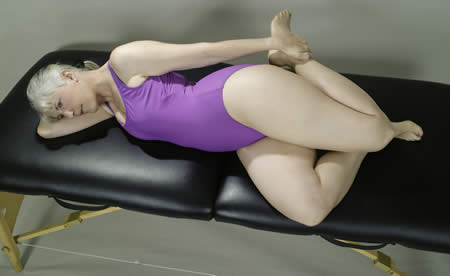
Quadriceps Side-lying stretch
Remember that these are only a few of the muscle which may contain trigger points that can refer pain to the knee area, so additional muscles may need to be treated to obtain relief. For a complete treatment program for knee pain caused by trigger points, see Pain Relief with Trigger Point Self-Help (Lotus Publishing. 2011.).
Artwork and Publication Acknowledgement
Artwork and self-help techniques used by permission from Lotus Publishing and Alaskan Natural Care, Inc. For information on techniques for treating any area of the body, see Pain Relief with Trigger Point Self-Help ISBN: 978-1-905367-25-2 at www.lotuspublishing.co.uk, reviewed by Anthony Agius BSc(Hons) Ost DO ND MBICAc MAO for Positive Health PH Online at www.positivehealth.com/review/pain-relief-with-trigger-point-self-help
Comments:
-
J.senthil nathan said..
Very useful. But we must see adductors Trigger points also.